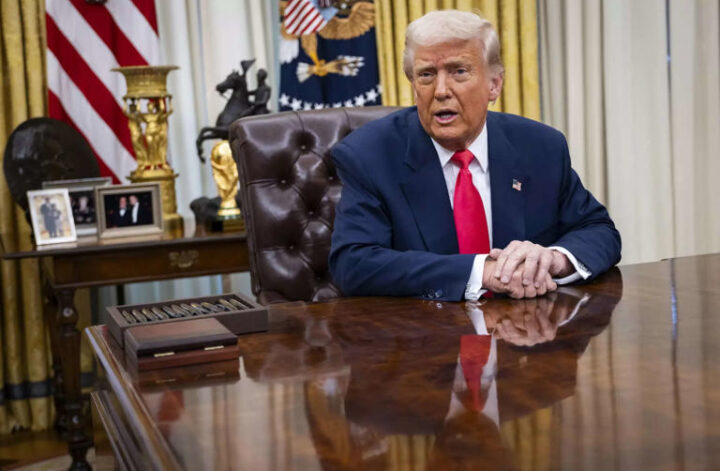Trump’s policies are affecting Indo US relations and impacting India. Not a day passes when a new order by Trump nudges the existing cordiality of ties. The latest ridiculous one on revocation of visas of Indian students who skip classes. A social-media screening rules of non US students too is in the pipeline. As per another order remittances by Indian will be taxed 5% of which I will talk later.
Saying that Modi is a good friend and that India is a tariff abuser in the same breath is an art that only Trump can triumph. As for India, this time we see it bending backwards to dance to the tune of Trump when we see Prime Minister Modi’s deafening silence at Trump’s India thrashing, his rehypenating India and Pakistan as also reworking on reducing or finishing tariffs on whisky and Harley Davidson motorcycles. I would say, whats going on here!
In what was once hailed as a “natural alliance,” the bond between the United States and India has hit turbulent waters this time (in Trump’s second term.) While diplomatic niceties and photo ops have maintained a surface-level camaraderie, a closer look at the policy trenches reveals a different story—one of friction, economic bruising, and a slow but visible drift toward an adversarial relationship. Trade, tariffs, jobs, immigration, and remittances—the very arteries that once pumped vitality into bilateral ties—are now being constricted under the weight of America’s increasingly protectionist stance.
Trade and Tariffs: From Partnership to Price War
Donald Trump’s America-first agenda has cast a long shadow over global trade, and India hasn’t escaped the crossfire. Trump’s blunt labeling of India as a “tariff king” set the stage for a trade standoff. In response, the U.S. slapped retaliatory tariffs on a range of Indian exports—from textiles and rice to car parts and leather goods. For India, which counts the U.S. as a key trading partner, this blow couldn’t have come at a worse time.
The financial toll is stark: India could stand to lose nearly $7 billion annually in export revenue, with about 87% of its U.S.-bound goods caught in this web of trade penalties. Indian exporters, already squeezed by global uncertainty, are now facing increased costs and shrinking margins. The much-touted goal of hitting $500 billion in bilateral trade by 2030 seems, at present, more pipe dream than plan.
Jobs and Immigration: An American Dream Deferred
The tightening noose around U.S. immigration policy is perhaps where the impact is felt most viscerally by Indians. Indian professionals, especially in the IT sector, have long formed the backbone of the H-1B visa workforce. But under Trump’s second-term agenda, getting that coveted visa has become a gamble. Applications are being scrutinized like never before, with approval rates plunging and wait times stretching endlessly.
Indian IT companies, caught between the devil and the deep blue sea, are now being pushed to hire locally in the U.S.—a move that not only hikes their costs but erodes their competitive edge. And the knock-on effects don’t stop there. The rollback of work permits for H-4 visa holders—often spouses of H-1B professionals—has shattered the financial equilibrium of many Indian households. One income, instead of two, in one of the world’s most expensive countries, is more than a pinch—it’s a punch to the gut.
Deportation and Fear: A Tense Climate for Indian Diaspora
Then comes the grim specter of deportation. Thousands of undocumented Indian nationals have already been shown the door. But the larger consequence is psychological: a climate of fear and uncertainty has settled over even those who are legally present. Stories of Indian students abruptly quitting their courses or professionals hastily resigning from jobs have become far too common.
The Indian government, though diplomatically restrained in public, has been forced to facilitate the return of deportees—many of whom left behind lives, aspirations, and often U.S.-born children. It’s not just individuals who are affected; this growing unease could reshape Indian migration patterns for years to come.
Remittance Tax: A Costly Squeeze on India’s Financial Lifeline
One of the more under-the-radar yet deeply impactful proposals is the 3.5% tax on foreign remittances floated in Trump’s expansive “One Big Beautiful Bill.” This seemingly small percentage masks a big blow: the U.S. is the largest source of remittances to India, funneling billions of dollars each year into middle-class and rural households.
This tax threatens to drain that pipeline. Indian families rely on this steady stream to pay for essentials—education, medical care, weddings, even mortgages. Beyond the personal impact, there’s a macroeconomic one too: India’s foreign reserves, a vital buffer in global trade, depend heavily on remittance inflows. Worse still, if people start avoiding official channels to dodge the tax, the entire system risks descending into opaque, untraceable chaos.
A Diplomatic Tightrope: Friends in Photos, Foes in Policy
To be fair, Trump has repeatedly called Prime Minister Narendra Modi a “great friend.” The two leaders have shared stage moments and grand welcomes, from Houston to Ahmadabad. But beneath the smiles and soundbites, there’s growing dissonance. Friendship at the top hasn’t translated into ease on the ground.
From curbs on Indian tech to trade wars and financial clampdowns, the second Trump term has gradually eroded the goodwill that took decades to build. India, ever the careful balancer on the world stage, now finds itself forced into a strategic recaliberation. Strengthening ties with other powers—whether it’s the European Union, Southeast Asia, or even warming up to China—may no longer be a choice, but a necessity.
Weathering the Storm, or Drifting Apart?
The India-U.S. relationship has never been simple, but it has always been important. Under Trump’s second term, that relationship is being stress-tested like never before. Visa headaches, trade skirmishes, remittance squeezes, and rising deportations are pushing the partnership into a more hostile, less predictable phase.
India must now respond with clarity and confidence. That means shoring up its domestic economy, expanding global trade alliances, and most critically, protecting the interests of its diaspora in a world where the rules are changing fast.
India needs strategic adjustments. India must firstly diversify export markets (EU, Middle East, Africa) to reduce U.S. dependency. Secondly, boost domestic tech innovation to offset H-1B visa losses. Third, strengthen economic diplomacy to negotiate better trade terms and fourth, encourage reverse migration by creating high-skilled job opportunities in India.
The road ahead may still hold promise—but only if both sides decide it’s worth the journey.

